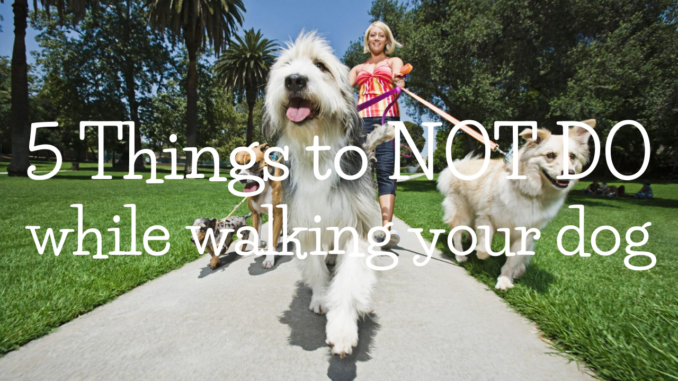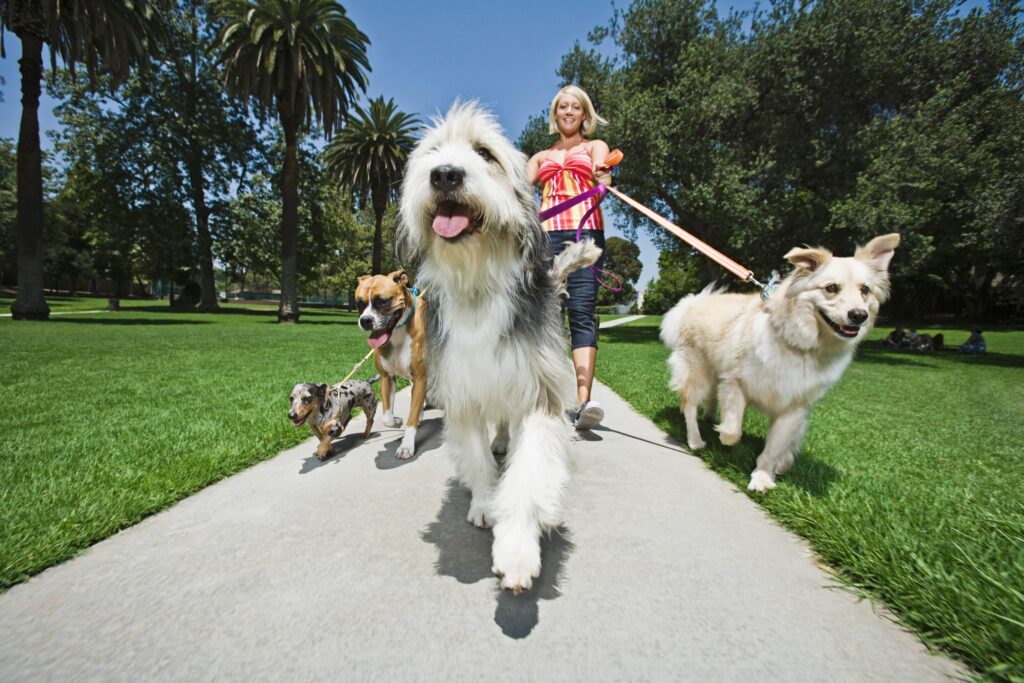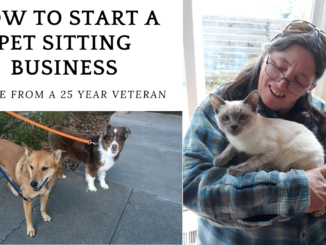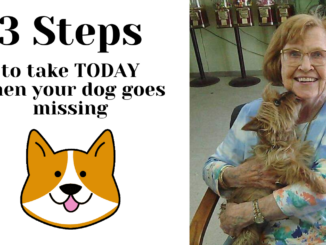
According to the American Pet Products Association, there are 90 million dogs in the United States. With all those dogs out walking with their owners and dog walkers, there are bound to be conflicts. In order to safely and effectively walk a dog you need to know what you should do as well as what you should not do. If you want to be a responsible guardian, follow this advice on five things to NOT DO while walking your dog.
1) Do not let your dog approach others.
There’s nothing worse than being out on a walk when you suddenly see another person and their dog walking straight towards you. You ask them to stop, but they keep coming, perhaps shouting, “My dog is friendly!”

Why do people do this? Do they assume that their wants overshadow everyone else’s? Do they live in a fantasy world where all dogs are friends? True, dogs are pack animals and in certain circumstances can get along in large groups, but walking on leash isn’t one of those circumstances. Many dogs are leash reactive, a natural response to feeling trapped and defensive when unable to flee. Even if they are not very reactive, a strange dog coming right up to their face can be very scary. Imagine if you were walking down the road and a stranger made a beeline for you then stared at your face and touched you! You’d be calling for the police.
This scenario can end badly in one of several ways: the dogs may get into a fight (and a person may be bitten trying to stop it), a fearful dog may slip his collar and run away, or a person may be pulled off balance and fall. Many dogs go missing in such situations, either slipping their collar or running off dragging the leash. Even if both dog and person get away uninjured, the dog may start to develop fears of walking, anticipating the approach of strange dogs, and may become more reactive in future. Be a responsible dog walker and a good neighbor and avoid others, giving them ample space to pass unbothered. If you want to walk with others, watch for a future article on safely walking in a group.

2) Do not overextend yourself.
Know your limits. Even as a professional dog walker, I don’t like to walk more than two dogs at a time. If you have multiple dogs, walk them in shifts or with the help of a friend. I have four dogs of my own and I walk them in two shifts. In the downtown area where I live, it’s just too risky to manage the whole pack at once. I never know when a loose dog will come around the corner, causing havoc, or when my crazy reactive terrier mix Kipper will suddenly lunge toward the street to attack a motorcycle or the garbage truck.
If you have strength or balance issues, don’t try to walk your 100lb German Shepherd who hasn’t been out all week. If your dog doesn’t walk well, sign up for a basic training class. They are usually offered at your local humane society, rec center, or private trainer’s facility. They are well worth the cost if you look at all you get, and if you practice. Like any other educational effort, you get out of it what you put in to it.
If you have physical challenges that prevent you from walking your dog or if you’re recovering from illness or injury, hire a professional dog walker to help keep your dog’s exercise routine going. Dogs confined to their house or property for weeks and months can easily become bored, destructive, and reactive.
3) Don’t rely on gadgets.
If your dog isn’t well trained and goes every which way on a walk, a wonder collar/leash won’t help. Some gadgets can even make matters worse; for example, a pinch collar or choke chain can make a dog fearful or angry, and an ill-fitted harness can slip right off. We’ve all seen those silly commercials on TV advertising some wonder product that has dogs trained in seconds. The widget will stop your dog from barking, jumping, and pulling on the leash for just three easy payments of $19.95. Dog owners must buy these products or the manufacturers wouldn’t pay for those ad slots on TV, and they must be disappointed when they don’t work as promised because there is no easy fix.
The best training device for your dog is time with you. Ever see homeless people walking down the road, dog or dogs trotting alongside, never wandering, eyes fixed adoringly on the owner’s face? These folks don’t have any fancy devices, sometimes using an old rope or whatever they have for a leash. What they have is time spent together, developing a bond and a relationship. You can’t buy that for $19.95.
4) Don’t walk naked.
This will get you some strange looks and might get you arrested! Seriously though, this means don’t let your pets go without ID. Too many people believe that their pets will never go missing so they don’t bother with ID tags, yet every day those same folks are at the animal shelter looking for their dog. I can’t tell you how many dogs I sit for who don’t have tags at all, or don’t wear collars in the house.

No one plans for their pet to go missing, yet it happens every day. Dogs jump fences, run out of open gates and doors, get away from their walker. When this happens, the only quick ticket home is an ID tag (microchips are also important, but more complicated). Basic ID tags cost just a few dollars and can be purchased at most pet stores or online. Make sure your dog’s tag is current! Every day animal shelters take in dogs with ID tags that are unreadable due to wear, engraved with an old disconnected phone number, or an old license or rabies tag that can’t be traced. More advanced tags with QR codes and digital information are available through companies like Pethub.
5) Don’t attach the leash to the buckle collar. in
See ID above. Buckle (or snap) collars are not designed for use on walks. They can easily break or slip off, leaving your dog loose and without ID. When I was walking one of my first dogs, a wild Labrador pup, I was unpleasantly surprised when she lunged towards something that got her attention and her (cheap grocery store) collar snapped right off! Fortunately she returned to me quickly, but it was a fun walk back to the car with her equally wild and excited sister. We recommend the martingale collar for use on walks, as it can be adjusted to fit and won’t slip off even if the dog backs up. There are a variety of collars and harnesses for walking, so check out your options at your local pet store or online. Make sure the collar or harness is properly fitted before stepping out. It goes without saying that you should also use a quality leash for walking. Nothing beats a stout six foot leash made of leather or nylon. Whichever you use, check the stitching from time to time, and check the leash itself for wear if your dog is inclined to chew on it when you’re not looking! If you like retractable leashes, read this article for cautions on their safe use.
Happy Walking!




